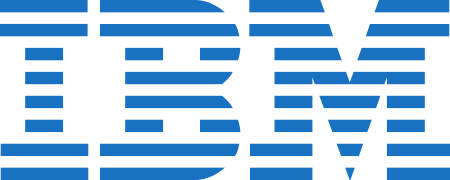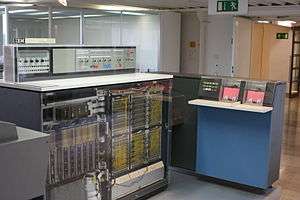IBM System/360 Model 20
 | |
 An IBM System/360 Model 20 (with front panels removed), with IBM 2560 MFCM (Multi-Function Card Machine) at right | |
| Manufacturer | International Business Machines Corporation (IBM) |
|---|---|
| Product family | System/360 |
| Release date | November 1964 |
| Memory | 4–32 KB Core |
The IBM System/360 Model 20 is the smallest member of the IBM System/360 family announced in November 1964. The Model 20 supports only a subset of the System/360 instruction set, with binary numbers limited to 16 bits and no floating point.[1] In later years it would have been classified as a 16-bit minicomputer rather than a mainframe, but the term "minicomputer" was not current, and in any case IBM wanted to emphasize the compatibility of the Model 20 rather than its differences from the rest of the System/360 line. It does, however, have the full System/360 decimal instruction set, that allows for addition, subtraction, product, and dividend of up to 31 decimal digits.
Developed by IBM in Böblingen, Germany,[2]:pp.217–218,352 the system was intended for data processing and as a replacement for tab equipment. An incompatible small computer, the IBM 1130 introduced the following year, was designed for scientific and engineering computing.
The design of the Model 20 was the result of a tug of war within IBM. John Haanstra had wanted a low-end machine that could execute IBM 1401 instructions. Fred Brooks wanted the machine to have System/360 architecture. The final result was a compromise where cost concerns predominated: the system leased for under $2000 per month including MFCM and line printer, compared to around $3000 for a comparable 1401.[2]:p.446
Based on number of systems sold the Model 20 was the most successful model of System/360. According to Pugh "The number of Model 20 processors installed by the end of 1970 in the United States exceeded 7,400."[2]:p.639 Other models, however, brought in greater revenue.

Architecture
The Model 20 was available with six memory sizes: 4, 8, 12, 16, 24 and 32 KB. As in other models of System/360 memory is byte-addressable.[1]:p.1 It has eight 16 bit general purpose registers numbered R8 through R15 which can be used in computations as base registers. All of memory is also directly addressable through a feature, called direct addressing, that combines the twelve bit displacement and the low-order bits of what would normally be the base register field of the instruction (R0-R7) to form a combined fifteen bit address.[1]:p.4 No storage protection is provided, except for the low 144 bytes of "protected area".
The instruction set is a subset of System/360 consisting of 37 instructions instead of 143,[1]:pp.7–25[3]:p.384 with some incompatible instructions, such as a BASR (Branch And Store Register) rather than BALR (Branch And Link Register).
- Binary arithmetic uses the S/360 "halfword" instructions to operate on 16-bit quantities. Load Halfword, Add Halfword, Subtract Halfword, Compare Halfword, and Store Halfword were available, along with Add Register and Subtract register,
- Decimal arithmetic includes the complete S/360 decimal instruction set for operations on packed decimal operands of up to 31 digits plus sign in storage.
- Logical instructions are Move Characters, Move with offset, Move Immediate, Move Numerics, Move Zones, Compare Logical Immediate, Compare Logical Characters, Edit, And immediate, Or immediate, Test under Mask, and Translate. One logical instruction unique to the Model 20 is "Halt and Proceed" (HPR, operation code X'99') which will quiesce input/output and stop the processor displaying a code to the operator. Operation can be restarted by pressing the "start" button.
- Branch instructions include standard S/360 Branch on Condition. Instead of "Branch and Link" the instruction set uses "Branch and Store" (BASR, X'0D', and BAS, X'4D') which functions similarly except that a 16 bit link address is stored. "Set PSW" (SPSW, X'B1'), which loads a 32 bit Program Status Word (PSW) replaces the standard "Load PSW". The Model 20 has no concept of privileged instructions or a distinction between supervisor state and user state so SPSW is available to user programs.
- Input/output instructions are unique to the Model 20. Lacking I/O channels all peripherals are directly controlled by the processor.
- "Test I/O and Branch" (TIOB, X'9A') which tests a specified device for any combination of four hardware-dependent conditions.
- "Control I/O" (CIO, X'9B') performs a control (non data) operation on a device.
- "Transfer I/O" (XIO, X'D0') performs a data transfer operation on a device. XIO starts a transfer and specifies the number of bytes to be read or written. Data transfer can optionally be performed by cycle stealing (IBM documentation calls this time-sharing), that is taking processor cycles from the user program as necessary to perform the operation.
Peripherals
As of 1967 the following peripherals were supported:[1]:pp.36–110
- IBM 2415 Magnetic Tape Unit with up to 6 tape drives.
- IBM 2560 Multi-Function Card Machine.
- IBM 2520 Card Read/Punch or Card Punch.
- IBM 1419 Magnetic Ink Character Reader.
- IBM 2311 Disk Storage.
- IBM 1442 Model 5 Card Punch.
- IBM 2203 Line Printer.
- IBM 1403 Line Printer.
- IBM 2501 Card Reader.
The system can also have an integrated communications adapter. Two adapter versions were available, one for Synchronous transmit-receive (STR) and one for binary synchronous communications (Bisync).
2311 Disk Storage
Model 20 disk storage uses IBM 2311 disk drives, model 11 or 12, attached to an integrated "storage control feature" on the CPU.[1]:pp.58–76 If multiple drives are attached they have to be the same model. Both models use the 1316 disk pack which provides a maximum of 203 cylinders with 10 tracks per cylinder. The model 11 uses all cylinders, the model 12 uses only the outermost 103. Each track is divided into ten sectors of 270 bytes each. The model 11 has a formatted capacity of 5.4 million bytes, and the model 12 of 2.5 million.[4]
Multi-Function Card Machine
A peripheral first offered on the Model 20 is the IBM 2560 Multi-Function Card Machine (MFCM). Because of its reliability problems, often involving card jams, the acronym was frequently interpreted as referring to many less favorable names. Nevertheless, the 2560 combines the functions of a card reader, card punch, interpreter, and card sorter, allowing the Model 20 to replace several separate pieces of punched-card equipment.
Because all I/O is performed by the processor the system is particularly suited to controlling timing-dependent devices such as the 2560, where a card can be read, punched into, printed on, and sent to a specified output stacker with tight timing requirements if full rated speed was to be maintained.
Software
Disk Programming System
The Disk Programming System (DPS) is a control program for a Model 20 with at least 12 KiB of memory and one disk drive. The components of DPS are:[5]
- The Initial Program Loader (IPL).
- A small resident monitor which handles disk input/output, error recovery, and job-to-job transition, and loads programs to be executed from the core-image library on disk.
- A Job Control Program loaded by the monitor between jobs handled job setup.
- Service programs for library management, I/O device table maintenance, linkage editing, and for loading and copying the systems residence disk, backing up and restoring other disk drives.
Rollout/Rollin allows the computer operator to interrupt a running batch program, execute an inquiry program, and then restart the batch job where it was interrupted.
Tape Programming System
Tape Programming Support (TPS) supports systems with magnetic tape drives but no disk drives. The minimum configuration for TPS is 4096 bytes of main storage, a card reader, a card punch, a printer and two magnetic tape drives. On such systems TPS provides an assembler and tape manipulation utility programs. Additional capabilities are provided on systems with 8192 bytes of main storage, and still more with four or more magnetic tape drives.[6]:pp.42-43
Card Programming Support
Card Programming System (CPS) is a set of control programs for a Model 20 computer system with only card input/output devices.
Languages
- Report Program Generator (RPG).
- PL/I subset, DPS only.[7]
- Basic Assembler versions were available for CPS, TPS, and DPS including Input/Output Control System (IOCS) macros and processing routines.
Other IBM programs
- Sort/Merge.
- Disk and tape utility programs such as initialize disk, initialize tape, clear disk.
Clones
The UNIVAC 9200 and 9300 processors were clones of the Model 20.
See also
- IBM System/360
- IBM 2922 Remote Job Entry terminal, based on the Model 20
References
- 1 2 3 4 5 6 IBM Corporation (1964). IBM System/360 Model 20 Functional Characteristics (PDF).
- 1 2 3 Pugh, Emerson W.; Johnson, Lyle R.; Palmer, John H. (1991). IBM's 360 and Early 370 Systems. MIT Press. ISBN 0-262-16123-0.
- ↑ Pugh, Emerson W. (1995). Building IBM: Shaping an Industry and Its Technology. MIT Press. ISBN 0-262-16147-8.
- ↑ “IBM 2311 Disk Storage Drive Models 1, 11 and 12 Field Engineering Theory of Operation” describes the IBM 2311, including models 11 and 12, used on System/360 model 20
- ↑ IBM Corporation (1969). IBM System/360 Model 20 Disk Programming System Control and Service Programs (PDF).
- ↑ IBM System/360 Model 20 Tape Programming System Operating Procedures “This publication provides Model 20 operators with the information required to operate their systems using the Model 20 Tape Programming System (TPS)”
- ↑ IBM Corporation (1968). IBM System/360 Model 20 Disk Programming System PL/I (PDF).
Further reading
- Basic Applications — System/360 Model 20 (E20-0098-0) "The purpose of this manual is to describe the IBM System/360, Model 20, and show how it may be used to process six basic applications: billing, accounts receivable, sales analysis, inventory control, accounts payable, and payroll."
- IBM System/360 Model 20 / Disk Programming System / Disk Utility Programs “The purpose of this manual is to show you how to use and modify the Disk Utility programs by describing the job-control and utility control statements and indicating the variety of disk operations these programs can perform.”
- IBM System/360 Model 20 Disk Programming System Control and Service Programs "This publication describes the purpose and functions of the Control and Service programs of the IBM System/360 Model 20 Disk Programming System (DPS)."
- IBM System/360 Model 20 / Card Programming Support / Basic Assembler Language “This reference publication provides programmers with the information required to write programs in the Basic Assembler language of the IBM System/360 Model 20.”